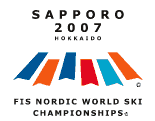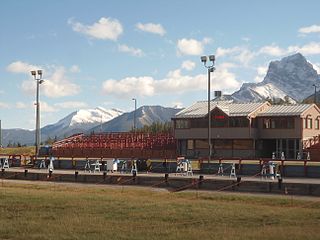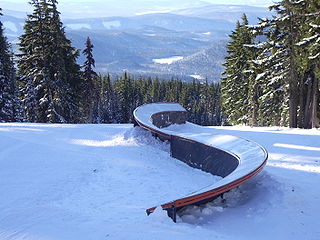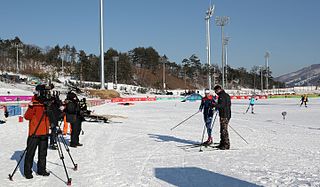
Skiing is the use of skis to glide on snow for basic transport, a recreational activity, or a competitive winter sport. Many types of competitive skiing events are recognized by the International Olympic Committee (IOC), and the International Ski and Snowboard Federation (FIS).

Winter sports or winter activities are competitive sports or non-competitive recreational activities which are played on snow or ice. Most are variations of skiing, ice skating and sledding. Traditionally, such games were only played in cold areas during winter, but artificial snow and artificial ice allow more flexibility. Playing areas and fields consist of either snow or ice.

Nordic skiing encompasses the various types of skiing in which the toe of the ski boot is fixed to the binding in a manner that allows the heel to rise off the ski, unlike alpine skiing, where the boot is attached to the ski from toe to heel. Recreational disciplines include cross-country skiing and Telemark skiing.

The 1964 Winter Olympics, officially known as the IX Olympic Winter Games and commonly known as Innsbruck 1964, was a winter multi-sport event which was celebrated in Innsbruck, Austria, from January 29 to February 9, 1964. The city was already an Olympic candidate, unsuccessfully bidding to host the 1960 Games. Innsbruck won the 1964 Games bid, defeating the cities of Calgary in Canada and Lahti in Finland. The sports venues, many of which were built for the Games, were located within a radius of 20 km (12 mi) around Innsbruck. The Games included 1,091 athletes from 36 nations, which was a record for the Winter Games at the time. Athletes participated in six sports and ten disciplines which bring together a total of thirty-four official events, seven more than the 1960 Winter Olympic Games. The luge made its debut on the Olympic program. Three Asian nations made their Winter Games debut: North Korea, India and Mongolia.
The 1972 Winter Olympics, officially the XI Olympic Winter Games and commonly known as Sapporo 1972, were a winter multi-sport event held from February 3 to 13, 1972, in Sapporo, Hokkaido Prefecture, Japan. It was the first Winter Olympic Games to take place outside Europe and North America.

Seefeld in Tirol is an old farming village, now a major tourist resort, in Innsbruck-Land District in the Austrian state of Tyrol with a local population of 3,312. The village is located about 17 km (11 mi) northwest of Innsbruck on a plateau between the Wetterstein mountains and the Karwendel on a historic road from Mittenwald to Innsbruck that has been important since the Middle Ages. It was first mentioned in 1022 and since the 14th century has been a pilgrimage site, benefiting not only from the visit of numerous pilgrims but also from its stacking rights as a trading station between Augsburg and the Venice. Also since the 14th century, Tyrolean shale oil has been extracted in the area. Seefeld was a popular holiday resort even before 1900 and, since the 1930s, has been a well known winter sports centres and amongst the most popular tourist resorts in Austria. The municipality, which has been the venue for several Winter Olympics Games, is the home village of Anton Seelos, the inventor of the parallel turn.

The FIS Nordic World Ski Championships 2007 took place 22 February – 4 March 2007 in Sapporo, Japan. It was the second time this city has hosted these championships, having previously done so in the 1972 Winter Olympics. Sapporo was selected as venue by vote at the 43rd FIS World Congress in Portorož, Slovenia, on 6 June 2002. It also marked the third time the championships were hosted outside Europe in a year that did not coincide with the Winter Olympics; it was the first championship held in Asia. The ski jumping team normal hill event was not held, as it had been in 2005.

Canmore Nordic Centre Provincial Park is a provincial park in Alberta, Canada, located immediately west of Canmore, 105 km (65 mi) west of Calgary.

The following outline is provided as an overview of and topical guide to skiing:

The Whistler Olympic Park is the location of the Nordic events facilities for the 2010 Winter Olympics and is located in the Madeley Creek basin in the Callaghan Valley, west of Whistler, British Columbia, Canada. The facility hosted the biathlon, cross-country skiing, Nordic combined, and ski jumping. After the Olympics the park remains a public facility, complementing the extensive wilderness trails and alpine routes already in use. Three temporary stadiums were built with a capacity for 12,000 spectators each. The location is approximately 8 km from the junction of its access road with Highway 99 and 14 km from the Whistler Olympic Village.
At the FIS Nordic World Ski Championships 2009 in Liberec, Czech Republic, four Nordic combined were held. It also showed the biggest format changes since the introduction of the Gundersen method at the 1985 World Championships in Seefeld, Austria. In addition to the 10 km mass start event, there were changes in the Gundersen-based individual events. The 7.5 km sprint event was changed to a 10 km individual large hill event while the 15 km individual event was changed to a 10 km individual normal hill event with both being approved in September 2008. These changes also affected the Nordic combined program for the 2010 Winter Olympics in Vancouver though the mass start was excluded. The United States, which had two medals in Nordic combined prior to this championships, won a total of four medals with three golds and a bronze. Todd Lodwick, whose previous best individual finish at the world championships was 13th in the 7.5 km sprint at Oberstdorf in 2005, won golds in the 10 km mass start and 10 km individual normal hill events. His teammate Bill Demong won a gold in the 10 km individual large hill and bronze in the 10 km individual normal hill events. Germans Tino Edelmann and Björn Kircheisen each won a silver in the 4 x 5 km freestyle team event, then won individual silver medals in the 10 km mass start and 10 km individual large hills events, respectively. France's Jason Lamy Chappuis earned two bronze medals, earning them in the 10 km individual large hill and 10 km mass start. Norway's Jan Schmid won a silver in the 10 km mass start and a bronze in the 4 x 5 km freestyle event. A fourth American medal was prevented when Demong was disqualified in the ski jumping part of the 4 x 5 km freestyle team event for failing to wear his bib during competition, dropping the US to 12th and forcing their withdrawal from the cross country portion of the event. The Japanese won their first gold medal at the championships in the team event since 1995 when they edged the Germans in a photo finish. Current World Cup leader Anssi Koivuranta of Finland has a disappointing world championships, earning his best finish of fourth both in the 10 km individual normal hill and 10 km mass start events. Norway's Magnus Moan, second in the World Cup standings, also had a disappointing championships as well, with a best place finish of fifth in the 10 km individual large hill events even though he set the fastest cross-country skiing portion time in both the 10 km individual large hill and the 10 km individual normal hill events.
The men's individual normal hill/10 km Nordic combined competition for the 2010 Winter Olympics in Vancouver, Canada, was held at Whistler Olympic Park in Whistler, British Columbia, on 14 February.
The 2009/10 FIS Nordic Combined World Cup was the 27th world cup season, a combination of ski jumping and cross-country skiing organized by FIS. It started in Kuusamo, Finland on 28 November 2009 and ended on 14 March 2010 in Oslo, Norway.

For the 1998 Winter Olympics in Nagano, Japan, a total of fifteen sports venues were used. Nagano had attempted twice to host the Winter Olympics, losing out to Sapporo, host of the 1972 Winter Olympics. The third time, in 1991, Nagano edged out Salt Lake City to host the 1998 Games. The biathlon venue was adjusted in accordance with the Washington Convention over endangered species. The biggest venue controversy was at Happo'one resort on the length of the men's downhill and the battle that ensued to the point where skiing officials threatened to pull the event entirely before a compromise was reached three months before the Olympics. M-Wave has hosted three World Speed Skating Championships since the Olympics, while the Spiral has hosted a couple of world championships in bobsleigh, luge and skeleton.

Toni-Seelos-Olympiaschanze is a ski jumping hill in Seefeld outside of Innsbruck, Austria. It is a part of the Seefeld Nordic Competence Centre consisting of two hills, a normal hill with a hill size of HS109 (K-99) and medium hill with at HS75 (K-68). Next to the jumps is a cross-country skiing stadium. It opened in 1931 as Jahnschanze, but was renamed in honor of Anton Seelos in 1948.

The 41st FIS Nordic World Ski Championships were held from 20 February to 3 March 2019 in Seefeld in Tirol, Tyrol, Austria. It was the second time Seefeld in Tirol hosted the world championships, the event having been hosted there previously in 1985.
The 2014/15 FIS Nordic Combined World Cup was the 32nd world cup season, a combination of ski jumping and cross-country skiing organized by FIS. It started on 29 November 2014 in Ruka, Finland and ended on 14 March 2015 in Oslo, Norway.
The 2015/16 FIS Nordic Combined World Cup was the 33rd World Cup season, organized by the International Ski Federation. It started on 4 December 2015 in Lillehammer, Norway and ended on 6 March 2016 in Schonach, Germany.

Alpensia Cross-Country Skiing Centre and Alpensia Biathlon Centre are sport venues in the Alpensia resort, located in Daegwallyeong-myeon, Pyeongchang-gun, Gangwon-do, South Korea. They are used for cross-country skiing and biathlon respectively. Each grandstand of the two venues is contiguous and similar in appearance. They also adjoin the ski jumping hills. In the non-winter season, the venues are also used as golf courses named Alpensia 700.

Granåsen Ski Centre is a winter sport venue located in Trondheim, Norway. Granåsen Ski Centre frequently hosts competitions arranged by FIS; Ski jumping World Cup and Continental Cup, Nordic combined World Cup and has hosted events in the Cross-Country World Cup on five occasions and Biathlon World Cup on one occasion. The FIS Nordic World Ski Championships 1997 took place at Granåsen.














